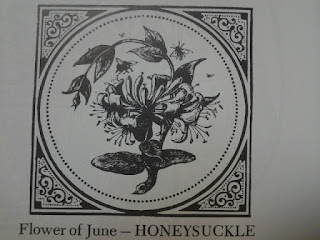So it has been quite a while since my last post and I do apologize for that. To make up for that, today's post features several different flowers. What better way to welcome the arrival of June and of the summer season than to introduce the flowers of June?
During the Middle Ages, the twelve months of the year were governed by agricultural affairs of the farmer, the chores of his wife, and the personal pleasures and relaxations of both. For that reason, along with the astronomical, meteorological, and agronomical information provided, the calendar was of the utmost importance to the farmer, more so than to anyone of any other trade. After the Middle Ages, in the flirtatious 18th century and more poetically-inclined 19th century, Western calendars began adopting flowers and plants for each month, based on seasonal appearances.
The flower for June was the honeysuckle which, in a medieval mode of communication known as the Language of Flowers, was also used to symbolize devotion and affection, generosity and gaiety, or a bond of love.
Common Name: Honeysuckle
Genus: Lonicera
However, it is not only throughout Europe, but Asia as well, where flowers are assigned to each month. In China, for example, a deep devotion and appreciation has been paid to flowers since the early ages and symbolic meaning given to each flower since antiquity. The Chinese have their own flower calendar, and for June, the flower is the pomegranate blossom. The pomegranate blossom was believed to be a symbol of progeny and prosperity, while the pomegranate itself was used as a symbol of a hopeful future.
Common Name: Pomegranate Blossom
Genus: Punica
Chinese: 石榴 (shíliú) [Not sure what Romanization the book used--I've used Mandarin pinyin]
Similarly, the Japanese have their own flower calendar. Japan in itself is a culture steeped with an appreciation for nature, with flower lore and legend permeating Japanese literature, and symbolic flower art such as the arrangement of flowers, Hana-ike (flower arrangement) or Ikebana (arranged flowers), both of which date back to over a thousand years old, embedded in everyday life. One of the oldest and most popular card game in Japan--Hana-garuta--has 48 cards, twelve of which represent the Japanese flowers of the months. For June, the peony flower was assigned. Besides being the flower of June, the peony also stood for gay life and prosperity, as well as a happy marriage and virility.
Common Name: Peony
Genus: Paeonia
Japanese: 牡丹 (botan)
That's all for today--I hope everyone has a wonderful June and a beautiful summer! Until next time then!
Many thanks to my wonderful wonderful sister for getting me the book I used for research for this post~~
Sources




No comments:
Post a Comment